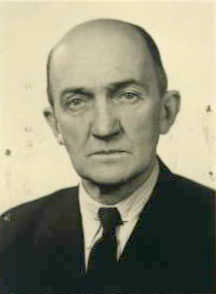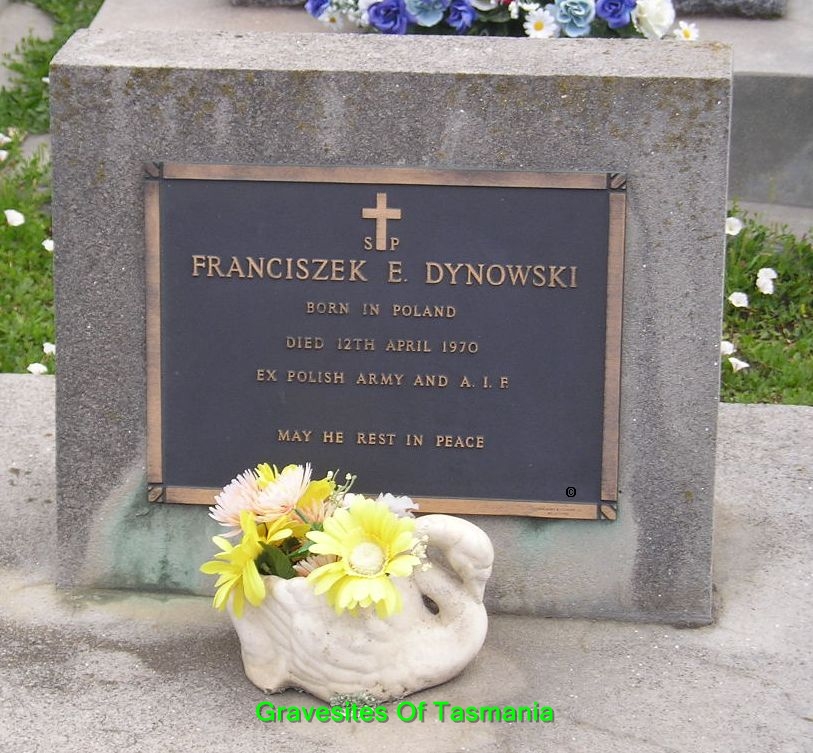Frank Dynowski
| Alias | Frank Edward, Franciszek |
|---|---|
| Russian spelling | Франк (Франтишек) Дыновский |
| Born | 19.05.1894 |
| Place | Kiev, Ukraine |
| Ethnic origin | Polish |
| Religion | Roman Catholic |
| Father | Josef Dynowsky, president of Barristers' committee |
| Mother | Maria Tyszkiewich |
| Family | Wife Mary Dynowski (née Hue), married 1918 in France; wife Lissi-Henriette Dynowski (née Lohrmann), married 1948 |
| Residence before arrival at Australia | Served in Russian field artillery |
| Arrived at Australia |
from Antwerp, Germany on 27.04.1914 per Gneisenau disembarked at Sydney |
| Residence before enlistment | Bugaldie via Coonabarabran, NSW |
| Occupation | 1916 labourer, 1950 engineer, 1952 waiter |
| Naturalisation | 1952 |
| Residence after the war | in 1919 intended to live in Havre; Poland 1919-1944, took part in Warsaw insurrection in 1944; Germany in 1944-1950 (served in Polish forces); arrived at Australia on 26.09.1950, lived in Hobart |
| Died | 12.04.1970, Hobart, Tasmania |
Service #1
| Service number | 1694 |
|---|---|
| Enlisted | 22.01.1916 |
| Place of enlistment | Gulgong NSW |
| Unit | 45th Battalion |
| Rank | Private, Corporal, Acting Sergeant |
| Place | Western Front, 1916-1919 |
| Discharged | 27.07.1919 in London |
Materials
Naturalisation (NAA)
Letter regarding certificate of naturalisation (NAA)
Digitised service records (NAA)
Digitised Embarkation roll entry (AWM)
Digitised incoming passenger card (NAA)
Blog article
Newspaper articles
First A.I.F. Man Returns as Migrant. - Age, 26 September 1950, p. 2.
From Falling stars: The story of Anzacs from Ukraine:
Meanwhile in war-torn Europe, Ukraine, and Russia, the story of our Anzacs continued. One of them was Frank Dynowski, who came from a cultured Polish family in Kyiv and worked in outback New South Wales as an agricultural labourer. He married while serving in the AIF and stayed in France. Later he moved to Poland and, according to the Age, during the Second World War joined the Polish army with the rank of major, 'was taken prisoner by the Russians, escaped, and then helped organise the Polish underground movement'. He took part in the 1944 Warsaw Rising, in which 'all my effects as well as the army documents were destroyed', he wrote when applying for replacements. Captured by the Germans, he was kept as a prisoner of war in a camp in Lubeck and after the war served in the Polish forces in Germany. In 1950 he returned to Australia in the wave of displaced persons. By that time he had trained as an engineer, but on settling in Hobart he had to turn again to waiting tables.
Gallery

Frank Dynowski
NAA, P1185, DYNOWSKI

Franciszek Dynowski grave in Tasmania
Cornelian Bay Cemetery
 Russian Anzacs
Russian Anzacs